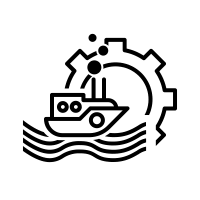
Introduction
Marine Engineering is a multidisciplinary field focusing on the design, construction, operation, and maintenance of marine vessels. It encompasses various engineering principles to ensure efficient and safe maritime operations.
History and Evolution
- Origins trace back to ancient civilizations crafting boats for transportation and fishing.
- Significant advancements during the Industrial Revolution.
- Introduction of steam power revolutionized marine transportation.
- Developments in diesel engines, gas turbines, and nuclear propulsion.
- Transition from wooden ships to advanced metal structures.
Core Principles and Components
- Fundamental principles: hydrodynamics, thermodynamics, mechanics, and electrical systems.
- Naval architects focus on hull design and stability.
- Mechanical engineers design propulsion systems for efficiency.
- Electrical engineers oversee automation and navigation systems.
- Importance of safety standards in design and construction.
Applications and Industries
- Commercial shipping includes container vessels and cruise liners.
- Naval defense applications in warships and submarines.
- Offshore oil and gas industries require specialized engineering.
- Marine research contributes to sustainable practices.
- Emerging industries like renewable energy integration in maritime operations.
Challenges and Innovations
- Environmental sustainability is a growing concern.
- Technological advancements reshape maritime operations.
- Compliance with evolving safety regulations.
- Economic factors impact design and operation.
- Innovations in alternative fuels and eco-friendly designs.
Future Prospects and Trends
- Digitalization and IoT transform vessel operations.
- Electrification trends reduce emissions significantly.
- Integration of renewable energy sources is key to sustainability.
- Autonomous vessels are emerging in the maritime industry.
- Future innovations focus on efficiency and safety enhancements.
Conclusion
Marine Engineering plays a crucial role in advancing maritime operations and infrastructure. Its evolution reflects a blend of tradition and modern innovation, addressing contemporary challenges while paving the way for a sustainable future in marine transport.